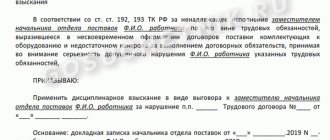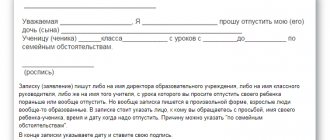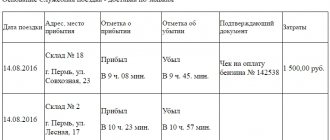Who can demand an explanatory note
An explanatory note about non-fulfillment or improper performance of official duties must be personally drawn up by the employee. This type of memo is necessary so that the head of the organization can objectively consider the situation and make a decision on the guilt or innocence of the subordinate.
The manager can request an explanation either orally or in writing. Thus, Article 193 of the Labor Code of the Russian Federation states that the director has the right to demand an explanation from a subordinate if he commits a disciplinary violation. If a written request is submitted, it may be in the form of an order or direction. After it is handed over to the employee, a mark of delivery is given.
Note! It is advisable to send the employee a written request regarding the need to provide an explanatory note. If the case is then considered in court, the manager will be able to easily confirm the fact that he requested an explanatory note from the employee.
However, labor legislation does not establish an employee’s obligation to provide written explanations. Therefore, the employee has the right to refuse to write an explanatory note. However, this fact does not prevent the employee from being reprimanded or fired if his guilty actions are proven.
Why is it compiled?
An explanatory note is a written form of explanation of the reasons why an employee failed to complete a task, violated some rule, or completely ignored his professional responsibility. The Labor Code also requires workers to provide all types of explanations for misconduct only on paper.
There are a number of reasons for this:
- There is no way to correctly understand spoken language, since sometimes words can explain things ambiguously or convey contradictory meanings to them.
- The recorded information will not be lost and will be a document for further investigation of the incident.
- There is no possibility to change the data and make adjustments to it, which can also affect the course of the official investigation.
- Lack of emotional coloring and bias towards a person during a personal conversation.
- Objective recording of data without personal intervention.
- Long-term storage.
The explanatory note should not be considered a verdict. Its presence is aimed at a loyal and objective consideration of the incident. It specifies all the reasons and circumstances that contributed to the current situation.
How do you spell
When writing an explanatory note, the subordinate must present the facts very concisely without indicating unnecessary details. In particular, the note must indicate:
- Confirm your guilt in dereliction of duty or refute it;
- Describe the factual circumstances of the case (date, place and time of the error in the work);
- Indicate your opinion regarding disciplinary action and further work.
Note! The main thing is to indicate in the note the reasons for failure to fulfill official duties, and at the same time it is advisable to find justifying circumstances for your action.
Most often, the reasons for failure to fulfill official duties are insufficient work experience, excessive workload, poor health, difficult family circumstances, vague definition of job responsibilities, etc.
In what case is an explanatory note written?
According to the law, when an employee commits any offense, the administration cannot immediately punish him.
The first step is to contact and ask the employee the reasons for the event. Further, the fact of violation of discipline or failure to fulfill duties is documented. The administration also has the right to request clarification from the violator in writing. The law gives the employee two days to draw up an explanatory note.
An explanatory note must be requested in the following situations:
- The employee is not at his workplace without the permission of management;
- The employee does not perform his job duties fully or does not perform them at all;
- The employee was late for the start of the working day;
- The company suffered material damage as a result of the actions or inaction of an employee;
- The employee is in his place under the influence of alcohol or drugs;
- The employee did not carry out a direct order from the manager, but this order is not within the scope of the employee’s job responsibilities;
- The employee conceals or distorts information about the state of affairs at the enterprise;
- The employee violates the safety rules (industrial, fire, etc.) established in the business entity.
Before rendering a verdict on the guilt of an employee, it is necessary to fully take into account all the circumstances of the event. Including the violator’s own vision of the situation.
The essence of the explanatory note is to ensure that the employee can, for his part, characterize his violation. The document records his testimony.
The employer must have this document in order to impartially understand the event that occurred.
Important: if an employee refuses to draw up a document, it is necessary to assemble a commission and record his refusal.
How to compose correctly
Variant of an explanatory note about failure to fulfill duties
It is necessary to draw up an explanatory note about failure to fulfill functional duties on a standard A4 sheet; you can write the note by hand or type the text on a computer. However, at the end of the explanatory note you must put your signature.
Such a document must contain the following details:
- In the upper right corner it is indicated to whom the form is being submitted: position, name of the enterprise and full name of the addressee;
- Next is the position and full name of the author of the document. For example, from accountant V.M. Smirna;
- In the middle of the form is written: “explanatory note”;
- The descriptive part describes the circumstances and reasons that led to the failure to fulfill official duties;
- At the end of the document is the date and signature of the employee.
Note! If necessary, you can attach evidence of your innocence or only partial guilt to the note.
If the disciplinary violation is not only your fault, then you should mention other participants in the incident, but you should not directly blame someone.
What needs to be indicated in the explanatory note
It is necessary to draw up an explanatory statement in such a way that its text reveals the incident as fully as possible on behalf of the violator.
First of all, the form must contain information about who issued the document for whom. The employee provides the most complete information about himself so that he can be easily identified (full name, name of department and position).
You also need to record the exact date and time when the event occurred. If the employee has valid reasons why this was done, everything must be described in detail further. Also, supporting documents are attached to the explanatory note.
The employee can evaluate his actions and either admit guilt or declare himself innocent. It is advisable that he include in his explanatory assessment of what happened, as well as his attitude towards the possible imposition of punishment.
If the employee admits his guilt, it is recommended to ask for forgiveness and also indicate that this offense will not be repeated in the future.
Attention: when composing the text of the document, all key facts must be presented in as much detail as possible, but at the same time, the document itself must be concise.
Sample note
For a better understanding of what an explanatory note regarding failure to fulfill official duties is, here is a sample of such a document:
To the director of the credit and consumer cooperative "Sun"
Antonov V.M.
from the manager of branch 17
Smirnova V.M.
Explanatory letter
I, Smirnov V.M., manager of department No. 17, provide an explanation for the failure to fulfill the plan for November 2020. Having analyzed the situation in connection with the failure to fulfill the plan for November 2016, I found out that this situation is connected with the recent bankruptcy of the consumer credit cooperative “Kopilka”. Many depositors of this credit institution have lost their deposits and, therefore, are spreading false information about the unreliability of other consumer credit cooperatives.
In this regard, the number of clients has halved since November 2020, and many of our clients come to the office demanding the return of their deposits. Therefore, I believe that it is not my fault for not fulfilling the plan. To solve the problem of a decrease in the flow of clients, I undertake to do additional work to advertise the services of our consumer credit cooperative.
Smirnov V.M. 02.10.2016
The note must be registered in the office. In order to protect yourself from illegal actions of management, it is advisable to draw up an explanatory note in two copies and put a receipt on the second completed form.
An example of an explanatory note about failure to fulfill official duties
Important nuances
Details of the circumstances that led to the offense/misdemeanor should be presented in as much detail as possible. This approach greatly facilitates the determination of the degree of legality of the actions taken.
The person drawing up the explanatory note may or may not admit guilt. In addition, it is advisable to express an opinion regarding the consequences and the attitude of the writer towards potential disciplinary measures.
The decision on the need to evaluate one’s own actions is made by the employee. If guilty is found, the relevant information is reflected in the document. In this case, it is advisable to insert into the text a phrase about preventing similar violations in the future.
Explanatory notes are usually written by hand. Printed varieties are less psychologically acceptable. Documents drawn up in this way reek of stereotypes, forming a biased (and in most cases unfavorable) attitude on the part of superiors. The manager may think that in front of him is a sample downloaded from the Internet, to which minor amendments have been made.
Types of disciplinary liability
Labor legislation stipulates that an employee may be reprimanded for failure to fulfill functional duties. If the employee has previously had reprimands, he may be fired for ignoring his job duties.
Important! Clause 5, Part 1, Article 81 of the Labor Code clearly states that dismissal for failure to perform work is permissible only if such a violation has already been committed at least once. If an employee does not cope with his work for the first time, it is prohibited to fire him.
Please also note that you cannot simultaneously reprimand the employee for one violation and subsequently dismiss the employee. Only if the employee is again subject to disciplinary action can he be dismissed, otherwise he can easily be reinstated to his position through the court.
Great article 0
What not to write in a note
In the explanatory note, the employee must explain the reasons for his action. He has the right to refuse to compile it.
But in the case when an employee wants to provide explanations, some things cannot be included in the text of the document:
- Incorrect data - the employer can check the facts stated in the explanatory note. If a lie is revealed, it will turn against the employee himself and lower his reputation in the eyes of the employer;
- Obscene language - the use of non-literary expressions is unlikely to add credibility to the facts presented. Therefore, when drawing up a document, it is necessary to use a dry business style of writing.
- There is no need to shift your blame onto other employees - in such a situation, explanatory notes may also be requested from those employees who will be mentioned in the note. And there it is no longer known what information they will provide. And it is very likely that relations with these employees will be damaged.
- It cannot be pointed out that the employee did not know about the need to comply with the rule - when hired, an employee becomes familiar with all the internal regulations of the business entity. In addition, an explanatory note may also be requested from the immediate supervisor with an explanation of the subordinate’s ignorance of his duties.
Causes
The reasons for writing a memo can be completely different. Here are the most common:
- being late for work;
- absenteeism, that is, absence from work for more than 4 hours in a row;
- failure to comply with the order of the immediate superior;
- failure to comply with subordination;
- behavior that does not comply with generally established norms and rules, or that contradicts the basic requirements of business ethics (for example, the use of obscene language);
- violation of labor discipline, expressed, for example, in obvious and deliberate disregard for safety precautions;
- appearing at work under the influence of alcohol or drugs;
- theft, damage to the employer's property;
- disclosure of commercial, official or other secret protected by law;
- other reasons.
Manager's actions
Any memo is created for the purpose of informing management. Its consideration is the responsibility of the director, his deputy, the head of the department authorized to do so by internal documents, charter, etc. Based on the results of the investigation on the facts stated in it, the director makes a certain decision. He sets out his will in a resolution, which subsequently serves as the basis for the execution of the manager’s decision.
This is important to know: Job responsibilities of a FAP paramedic
A disciplinary sanction is imposed only after receiving an explanation from the citizen against whom the notice was drawn up. Refusal to provide them is not an obstacle to taking response measures, but this refusal must be formalized in a separate act. It is also recommended to draw up an investigation into the circumstances of the incident in order to obtain the necessary evidence in case of subsequent proceedings with the participation of judicial authorities (the disciplinary sanction can be challenged by the employee). The penalty is valid for a year. Before the expiration of this period, it can be removed by decision of management. Moreover, the initiative for withdrawal can come from both the employee himself and his immediate supervisor, as well as a representative body or the head of the organization himself.
How to write a memo about failure to fulfill official duties
It’s good when there is a friendly atmosphere in the workplace and the team works as one well-coordinated mechanism.
But what if one or more people undermine discipline or refuse to fulfill their responsibilities, thereby jeopardizing the success of the entire team? In this case, you will have to draw up a complaint in the form of a memo .
Sample memo on failure to fulfill official duties
| Name of the department | Position of the manager in the dative case name of the organization Full name of the manager |
Memorandum
Date of preparation, serial number of the document
About non-fulfillment (regarding non-fulfillment) of job duties (job description)
I ask you to take into account the fact that the employee (department name) of the division (full name of the employee) did not fulfill his direct job responsibility (describe). By such behavior he/she violated Article No.... of the job description.
In connection with such circumstances, I propose (demand) to punish the above-mentioned employee (indicate the proposed punishment).
| Compiler's position | Author's signature: | Full name of the compiler |
Procedure for writing a note
The document is drawn up in the same order as any other official paper:
- First, the header of the document is written, which indicates:
– addressee – director or head of an enterprise, structural unit;
– addressee – author of the document, his position and last name, first name, patronymic.
- The title of the document, reflecting its essence.
- The explanatory text itself, which is arranged in the following order:
– date of the offense and its essence;
– consequences of failure to fulfill certain obligations;
– the reason for the offense;
– admission of guilt in the incident;
– a promise to continue to adhere to job descriptions.
- Date of preparation.
- Signature and its decoding.
Report template
The template or sample of the memorandum is not approved at the federal level. The requirements for its design and content, which are mandatory throughout the country, are not defined by the legislator.
GOST R 6.30 2003, GOST R 7.0.8 2013 in the field of office work have a methodological and recommendatory focus.
When writing a memorandum, the compiler is guided by his own experience and knowledge or by the organization’s office work instructions.
The compiler of the memorandum, in free form, sets out in detail incidents related to the employee’s failure to fulfill official duties, analyzes the causes of the current situation, and makes proposals and conclusions for management to make management decisions.
Design requirements:
- For the report, A4 paper is used, the dimensions of which are 29.7 by 21 cm, or A5 paper with a scale of 14.8 by 21 cm.
- The text field of the note is limited by the following parameters: the left margin is 2 cm from the edge of the paper, the right margin is 1 cm, the top margin is 2 cm; lower –2 cm.
- The note is numbered if there are several sheets in the document in Arabic numerals; however, the number is not placed on the first page, although it is taken into account when counting.
- As a rule, when writing a note, for better perception of the text of the note, the Times New Roman font of 12–14 pt is used.
- Since the memo refers to internal documents, the organization does not use a corner or longitudinal stamp.
So, the main elements of the design of a memorandum, that is, details:
- destination. The location of the props is the upper right corner of the first sheet near the right border of the document. The addressee indicates the position, initials and surname of the recipient of the note in the dative case;
- the name of the department that prepared the note - written 3 line spaces below the addressee, in the upper left part of the sheet to the middle of the text in one or more lines. The name is written in the nominative case without indicating the name of the company. If there is no division into departments and structural units in the organization, then this detail is missing;
- the name of the document - REPORT NOTE is printed in capital letters with 1 line spacing below the name of the department or 5 - after the addressee, near the left border of the text;
- registration number, date of registration (in organizations where internal documents are kept in office). The details are located 1 line spacing below the document title near the left border of the text field and are printed in one line. Printed in numeric format. The registration date coincides with the creation date;
- title to the text. This design element is located with two line spacing below the registration number or one - after the title of the document, next to the left margin. The title briefly summarizes the essence of the memo, and begins with the words: “About...”, “About...”. The maximum number of characters for the text title is one hundred and forty, and the line length is twenty-eight;
- text . This element is written with two line spacing below the heading. The indentation of the first line of a paragraph is 1.25 cm relative to the left border, aligned “to the width” of the text. The structure includes 2-3 paragraphs: The first paragraph is devoted to a description of what happened, the motives for writing the note, the name of the offender, and the essence of the offense. In the second , an assessment is made of the situation that has arisen and an opinion is expressed about the reasons for its occurrence. This part of the report is optional. The third paragraph contains the proposals, conclusions and judgment of the author of the note about the need for action, disciplinary and other liability. This part is advisory in nature, there are no requirements. The note is written in an official business style, without using filler words, concisely, clearly and presented by the compiler in the first person singular (I convey..., I propose...);
- signature. This element includes an indication of the position of the author of the note, a personal signature, and a transcript consisting of initials and surname. Each part of the signature takes up a third of the width of the text field. The originator signs the note;
- date of document preparation. Specified in numeric format. Written when there is no registration date.
The immediate supervisor of the guilty employee or the head of the organization’s personnel service writes a memo about failure to fulfill official duties.
The immediate superior or head of the personnel service requests an explanation from the guilty employee.
If necessary, acts and other documents confirming the failure to fulfill official duties are drawn up. If an employee refuses to provide written explanations, a corresponding act is drawn up. The act of refusal to give an explanation is signed by the persons present and the author. The completed documentation is submitted to the manager for review.
In private organizations, as usual, non-compliance with duties by employees is not documented in writing. All questions are resolved orally.
However, when an employee goes to court for restoration of violated rights, a written record of the fact of violation, including a memo, is significant material evidence in favor of its author.











